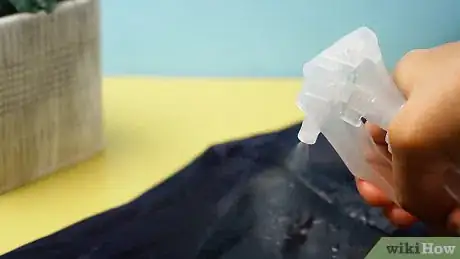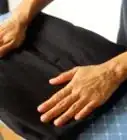This article was co-authored by Susan Stocker and by wikiHow staff writer, Janice Tieperman. Susan Stocker runs and owns Susan’s Green Cleaning, the #1 Green Cleaning Company in Seattle. She is well known in the region for outstanding customer service protocols — winning the 2017 Better Business Torch Award for Ethics & Integrity —and her energetic support of green cleaning practices.
There are 10 references cited in this article, which can be found at the bottom of the page.
wikiHow marks an article as reader-approved once it receives enough positive feedback. In this case, 100% of readers who voted found the article helpful, earning it our reader-approved status.
This article has been viewed 176,577 times.
As convenient as it would be, there’s unfortunately no “one ironing method fits all” for every type of fabric in existence. Unlike other durable fabrics, silk needs a lot of special TLC, especially when it comes to ironing. Thankfully, caring for your silk items doesn’t have to be too time-consuming—you just need to take a few extra precautions along the way.
Steps
Prepping the Silk
-
1Spritz the silk down with water so it’s damp. Silk is a tricky material to work with, especially since it’s more delicate than other fabrics. To prevent burning, spray down the surface of the material with tap water, which will help the ironing process go a lot more smoothly.
- If you iron dry silk, you may mess up the texture.
- It’s best to iron your silk right after you’ve washed it. Wait until the item is mostly dry but still slightly damp—this way, you may not have to spritz it down ahead of time.[1]
-
2Turn the clothing item inside-out to protect the silk. Since silk is so delicate, try to limit any contact the iron makes with the actual material. With this in mind, flip the item so it’s inside-out, which offers extra protection to the silk.[2]
- For instance, if you’re ironing a silk shirt, both the sleeves and the body need to be turned inside-out.
Advertisement -
3Smooth out the silk so it’s flat on your ironing board. Flatten any obvious wrinkles with your hands, so the fabric is as smooth as possible. If your silk item is really large, like a dress or dress shirt, you may have to work in segments.[3]
- For instance, if you’re ironing a dress shirt, you may start by flattening and ironing the chest portion before moving on to the sleeves.
-
4Arrange a press cloth on top of the silk. Don’t iron silk directly—since it’s really delicate, you need to have a “buffer” of sorts between the iron and the actual fabric. This is known as a “press cloth,” but it can really be any lint-free material that covers your silk. A small square of cloth will work just fine.
- Use a white or light-colored press cloth so no color transfers to your silk.[4]
- Go with a lint-free cloth so nothing transfers while you iron.
Ironing Instructions
-
1Adjust your iron to the lowest heat setting. Turn your iron way down, so you don’t risk damaging your silk in any way. A lot of modern irons come with special fabric settings—if your iron has this, set it to the “silk” setting instead.[5]
-
2Center the iron on the press cloth and press it down for a few seconds. Don’t worry about moving your iron from side to side—just focus on holding it one place. Press down for a few seconds. Don't go any longer than that or you might accidentally burn or damage the material.[8]
- Depending on what you’re ironing, it may help to work in a specific direction. For instance, if you’re ironing a silk tie, start at the bottom and work your way to the top.[9]
-
3Lift the iron straight up and give the silk a few seconds to cool off. Raise the iron straight up off the silk's surface before moving onto the next section of silk. Wait a few seconds so the material isn't super hot, then move onto another section of material.[10]
-
4Repeat this pressing and lifting pattern along your silk. Move the press cloth to another section of your silk item. Press the iron down for a few seconds before lifting it up again, moving the press cloth as you go. Continue this process until you’ve ironed the entire thing.[11]
- If you’re using a large press cloth that covers all of your silk, you don’t need to worry about shifting it around.
-
5Wear, display, or hang up your silk once you’re done ironing it. Wait for the silk to dry and cool off completely before taking it off the ironing board.[12] Turn the item right-side-out again before wearing or displaying the item.
- If you don’t plan on using the silk right away, hang it up in a dry, dark area, away from natural or fluorescent lighting.[13]
- If possible, keep mothballs or other moth deterrents near your silk, since moths are very attracted to silk.
Community Q&A
-
QuestionWhat will happen if I iron silk at a high temperature?
 PandasilkCommunity AnswerSet the iron to the minimum temperature, for an overheated iron may cause the fabric to turn yellow or fade.
PandasilkCommunity AnswerSet the iron to the minimum temperature, for an overheated iron may cause the fabric to turn yellow or fade.
Things You’ll Need
- Iron
- Press cloth
- Ironing board
- Water
- Water bottle
References
- ↑ https://www.loveyourclothes.org.uk/tips/how-wash-silk
- ↑ https://sewguide.com/washing-cleaning-silk/
- ↑ https://www.whowhatwear.com/how-to-iron-silk/slide6
- ↑ https://www.loveyourclothes.org.uk/tips/how-wash-silk
- ↑ https://m.youtube.com/watch?v=SCciNWvbcYk&t=1m5s
- ↑ https://www.fcs.uga.edu/extension/textile-basics-understand-your-fibers
- ↑ https://m.youtube.com/watch?v=SCciNWvbcYk&t=1m16s
- ↑ https://m.youtube.com/watch?v=SCciNWvbcYk&t=1m22s
- ↑ https://www.silkworm.co.uk/article/16/how_to_iron_silk_ties
About This Article
Silk needs some special TLC when you iron it so it doesn't get damaged, but the process is still really simple. Just spray the silk with water so it's damp, which will prevent it from burning, and turn the fabric inside out so you're ironing the back of it. Place a light-colored, lint-free cloth over the silk so you're not ironing directly onto it, and that's it! Use the lowest heat setting on your iron and only press down on the silk for a few seconds at a time. For tips on how to store silk to keep it wrinkle-free, scroll down!

























































